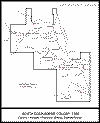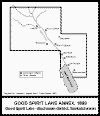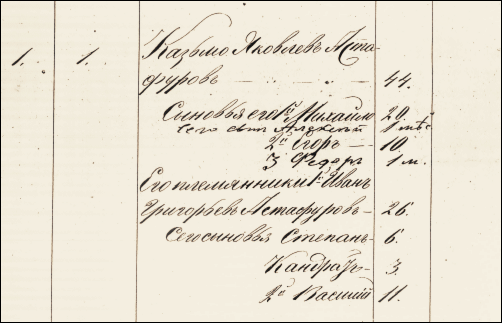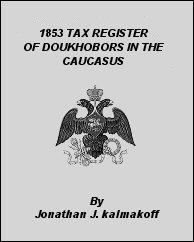by Jonathan J. Kalmakoff
The following index is of Doukhobor surnames that appear in the 1853 tax register (kameral’noe osipanie) of the Caucasus region of Imperial Russia. Search geographically by village to find the surnames that occurred in the village in 1853. Then follow the instructions at the bottom of this page to consult the full extracted and translated data from the tax register. See the Surname-Village Index to search alphabetically by surname.
Index – Elizavetpol Sub-District – Borchalo Sub-District – Akhalkalaki Sub-District
Elizavetpol Sub-District & District, Tiflis Province
Novo-Troitskoye
Androsov, Bludov, Dergousov, Efanov, Fedosov, Fofonov, Glukhov, Gnezdinov, Golovanov, Gulyaev, Khudyakov, Lunin, Novokshenov, Parakhin, Pereverzov, Plaksin, Plokhov, Popov, Robyshev, Rybin, Shchukin, Sherstobitov, Shilov, Skoblikov, Sukhachev, Svetlichnev, Terekhov, Vyatkin, Vyshlov.
Slavyanka
Abakumov, Agafonov, Andreev, Argatov, Babakaev, Bedinov, Beloivanov, Bludov, Bondarev, Bryunin, Bulanov, Chernenkov, Chernov, Danshin, Davidov, Dement’ev, Dorodlev, Dubasov, Dymovsky, Egorov, Eletsky, Evsyukov, Fedosov, Filipov, Fominov, Gerasimov, Golubov, Gorelkin, Gorshenin, Gritchin, Grushkin, Isakin, Ivanov, Ivashin, Kabatov, Kalesnikov (Kolesnikov), Kanigin, Karev, Kasogov, Kotel’nikov, Khabarov, Khilimov, Kinyakin, Kireev, Kolodin, Konkin, Korolov, Kovalev, Kozlachkov, Kryukov, Kunavin, Kuznetsov, Makhonin, Malov, Markin, Medvedev, Miroshnikov, Mitin, Morozov, Nemakhov, Nemanikhin, Nichvalodov, Ozerov, Panferkov, Peregudov, Pereverzov, Pepin, Petrov, Pikhtin, Planidin, Plotnikov, Podovinnikov (Podovil’nikov), Pogozhev, Polikarpov, Polovnikov, Popov, Posnikov, Pugachev, Raskazov, Repin, Sadkov, Safonov, Salikin, Samoylov, Saplin, Savinkov, Semenishchev, Semenov, Sherstobitov, Shishkin, Shtuchnoy, Shumilin, Shustov, Slastukhin, Soloveev, Strelyaev, Stupnikov, Sukharev, Sukhoveev, Susoev, Svetlikov, Tarasov, Terekhov (Terikhov), Trushin, Usachev, Vasilenkov, Vereshchagin (Verishchagin), Verigin, Vodopshin, Voykin, Vyatkin, Zaitsov, Zarshchikov, Zarubin, Zhivotov, Zhurav’lev, Zibarov, Zibin
Novo-Spasskoye
Antofeev, Borisenkov, Bortsov, Bykovskoy, Chevild’eev, Chutskoy, Fedosov, Gor’kov, Konkin, Kutnyakov, Lazarev, Makhortov, Nagornov, Negreev, Novokshenov, Obedkov, Parazikhin, Perepelkin, Rybalkin, Salikin, Sopov, Strelyaev, Vanzhov, Zbitnev
Novo-Goreloye
Abarovsky, Astafurov, Esaulov, Evsyukov, Fofonov, Goncharov, Gor’kov, Gubanov, Kalmykov (Kolmakov, Kalmakov), Khudekov, Lapshin, Malikov, Markov, Mukovnin, Parazikhin, Pereverzov, Rybalkin, Rybin, Ryl’kov, Samoylov, Samorodin, Sukhorukov, Tomilin, Trubitsin, Vyshlov, Zarchukov.
Borchalo Sub-district, Tiflis District, Tiflis Province
Bashkichet
Antufeev, Bludov, Chernyshev, Dement’ev, D’yakov, Obedkov, Nagornoy, Pogozhey, Skachkov, Vlasov.
Karabulakh
Dergausov, Kolesnikov, Rylkin, Salykin, Savitsky.
Karaklisi
Chekmarev, D’yakov, Kinyakin, Lazarev, Menyakin, Molchanov, Novokshonov, Parkin, Salychev, Shiveldeev, Sorokin, Strelyaev, Sviridov.
Ormasheni
Chernov, Drozdov, Goncharev, Glaskov, Perepelkin, Ponomarev, Rezantsov, Salykin, Savenkov (Savenko), Shkuratov, Slobodin, Vereshchagin, Zarshchikov.
Akhalkalaki Sub-district, Akhaltsikhe District, Kutaisi Province
Bogdanovka
Barabanov, Bedinov, Biryukov, Chernenkov, Chernov, Golishchov, Gremyakin, Grichin, Kolesnikov, Lebedev, Lezhebokov, Luk’yanov, Makhonin, Malakhov, Maslov, Matrosov, Molchanov, Naidenov, Novikov, Podavinikov, Padovsky, Perepelkin, Popov, Poznyakov, Repin, Saprikin, Shcherbinin, Shlyakhov, Sukharov, Vanin, Vasilenkov, Vereshchagin.
Spasskoye
Babaev, Bedin, Botkin, Chursin, Glukhov, Golubov, Il’in, Kinyakin, Kurbatov, Malov, Miroshnikov, Mitin, Nazarov, Ozerov, Petrov, Popov, Poznyakov, Repin, Skachkov, Stupnikov, Sukharev, Tamilin, Trofimov, Tsybulkin, Vasilenkov, Verigin, Voykin, Zbitnev.
Orlovka
Babakaev, Bedinov, Bortsov, Chekmarov, Cherkashov, Demin, Dorofeev, Dubinin, Dutov, Ereshenkov, Grichin, Gubanov, Gulyaev, Kalmykov, Katasanov, Kazakov (Kozakov), Kholodinin, Konkin, Karev, Krygin, Kuchin, Kudrin, Kuz’min, Laktin, Makhortov, Markov, Mudrov, Negreev, Nosov, Novokshonov, Perepelkin, Podkolzin, Posnikov, Povalyaev, Rezantsov, Ryl’kov (Rylkin), Romanov, Rozynkin, Salykin, Samoylov, Savenkov, Shchekin, Shchukin, Sotnikov, Storozhov, Strelyaev, Tikhanov, Tolmachev, Uglov, Uvarov, Vorobeev, Voronkov, Zakharov, Zubenkov.
Goreloye
Abrosimov, Astafurov, Balabanov, Baturin, Belousov, Borisov, Chuchmaev, Demin, Dubinin, Dutov, Eletsky, Gololobov, Goncharov, Gubanov, Il’in, Kalmikov, Khokhlin, Karev, Krasnikov, Krikunov, Kukhtinov, Larin, Lityagin, Markin, Medvedev, Nichvolodov, Pankov, Potapov, Pramorukov (Premorukov), Rybin, Salykin, Sapunov, Savenkov, Semenyutin, Shapkin, Shchukin, Smorodin, Sukhorukov, Sukhoveev, Tomilin (Tamilin), Taranov, Terekhov, Vlasov, Vyatkin, Zarubin, Zharikov, Zhmaev, Zubkov.
Efremovka
Abrosimov, Arishchenkov, Balabanov, Bezperstov, Chekmarov, Chuvel’deev, Dubasov, Fofonov, Gor’kov, Ivin, Lesnikov, Markin, Mukaseev, Nazarov, Nichvolodov, Novokshanov, Obetkov (Obedkov), Oslopov, Parakhin, Parkin, Pereverzev, Popov, Rezantsov, Rybin, Salykin, Samoylov, Sherstobitov, Shtuchnov, Tupikin, Vyshlov.
Troitskoye
Antyufeev, Bludov, Dubasov, Dutov, D’yakov, Fomin, Il’in, Kabatov (Kobatov), Kolesnikov, Konkin, Markin, Markov, Nadein, Putilin, Rybin, Slastukhin, Stroev, Sukharov, Turtsov, Vereshchagin, Verigin, Voykin, Yuritsin, Zaitsov, Zubkov.
Rodionovka
Arishchenkov, Borisenkov, Bykanov, Cherkashov, Chuvel’deev, Dutov, Evdokimov, Fomin, Glebov, Goncharov, Il’yasov, Khadykin, Khud’yakov, Kukhtinov, Kuznetsov, Lakhtin, Lavrenchenkov (Lavrenchikov), Lebedev, Lobintsov, Makeev, Markin, Mezentsov, Mzhel’sky (Mozhel’sky), Ostrikov, Plakhov, Popov, Potapov, Rozynkin, Safonov, Samsonov, Sopov, Strukov, Susoev, Verigin, Vlasov, Zbitnev, Zhmaev, Zubkov.
Shashka
Baturin, Bayov, Borisov, Bortsov, Chursin, Chutsenko (Chutsky), Demin, Glagol’ev, Gorkin, Katasanov, Kazakov, Kuchin, Kuranov, Kutnyakov, Levanov, Planidin, Ponomarev, Popov, Remizov, Rezantsev, Ryl’kov, Savenkov, Savitsky, Strelyaev, Trofimov, Vyshlov, Yashchenkov, Zubenkov.
Notes
According to the taxation register, in 1853, the Doukhobor population in the Caucasus was distributed in sixteen village settlements in the following areas:
- Four villages (Novo-Troitskoye, Slavyanka, Novo-Spasskoye and Novo-Troitskoye) in the Elizavetpol sub-district of Elizavetpol district, Tiflis province, Russia. Note: in 1868 this area became the Kedabek district of Elizavetpol province, Russia. Today it is the Gadabay region of Azerbaijan.
- Four villages (Bashkichet, Karabulakh, Karaklisi and Ormasheni) in the Borchalo sub-district of Tiflis district, Tiflis province, Russia. Note: in 1868 this area became the Borchalo district of Tiflis province, Russia. Today it is the Dmanisi district of Kvemo Kartli region, Georgia.
- Eight villages (Bogdanovka, Spasskoye, Orlovka, Goreloye, Efremovka, Troitskoye, Rodionovka and Shashka) in the Akalkhalaki sub-district of Akhaltsikhe district, Kutaisi province, Russia. Note in 1868 this area became the Akhalkalaki district of Tiflis province, Russia. Today it is the Ninotsminda district of Samtskhe-Javakheti region, Georgia.)
Explore these settlements further using the Google Map above to view a draggable map, satellite imagery and terrain map. Double-click the info windows for corresponding links to The Doukhobor Gazetteer and Google Earth!
If you have found a surname that you are researching and would like to see the full data from the tax register, consult the book 1853 Tax Register of Doukhobors in the Caucasus by Jonathan J. Kalmakoff. This book contains the information extracted from the original tax register schedules housed at the Georgian State Archives and translated into English. It includes: the name and age of the males in each household, the family relationship to the head of the household, the year of arrival from Russia, the number of males and females in each household and more.




















